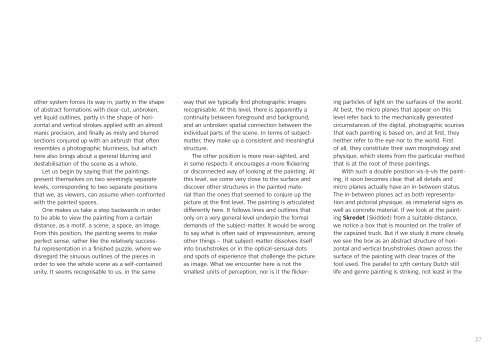Allan_Otte_Landskabsmaleri_2008 - 72 sider - 15 - TIFF ... - Allan Otte
Allan_Otte_Landskabsmaleri_2008 - 72 sider - 15 - TIFF ... - Allan Otte
Allan_Otte_Landskabsmaleri_2008 - 72 sider - 15 - TIFF ... - Allan Otte
You also want an ePaper? Increase the reach of your titles
YUMPU automatically turns print PDFs into web optimized ePapers that Google loves.
other system forces its way in, partly in the shape<br />
of abstract formations with clear-cut, unbroken,<br />
yet liquid outlines, partly in the shape of horizontal<br />
and vertical strokes applied with an almost<br />
manic precision, and fi nally as misty and blurred<br />
sections conjured up with an airbrush that often<br />
resembles a photographic blurriness, but which<br />
here also brings about a general blurring and<br />
destabilisation of the scene as a whole.<br />
Let us begin by saying that the paintings<br />
present themselves on two seemingly separate<br />
levels, corresponding to two separate positions<br />
that we, as viewers, can assume when confronted<br />
with the painted spaces.<br />
One makes us take a step backwards in order<br />
to be able to view the painting from a certain<br />
distance, as a motif, a scene, a space, an image.<br />
From this position, the painting seems to make<br />
perfect sense, rather like the relatively successful<br />
representation in a fi nished puzzle, where we<br />
disregard the sinuous outlines of the pieces in<br />
order to see the whole scene as a self-contained<br />
unity. It seems recognisable to us, in the same<br />
way that we typically fi nd photographic images<br />
recognisable. At this level, there is apparently a<br />
continuity between foreground and background,<br />
and an unbroken spatial connection between the<br />
individual parts of the scene. In terms of subjectmatter,<br />
they make up a consistent and meaningful<br />
structure.<br />
The other position is more near-sighted, and<br />
in some respects it encourages a more fl ickering<br />
or disconnected way of looking at the painting. At<br />
this level, we come very close to the surface and<br />
discover other structures in the painted material<br />
than the ones that seemed to conjure up the<br />
picture at the fi rst level. The painting is articulated<br />
differently here. It follows lines and outlines that<br />
only on a very general level underpin the formal<br />
demands of the subject-matter. It would be wrong<br />
to say what is often said of impressionism, among<br />
other things – that subject-matter dissolves itself<br />
into brushstrokes or in the optical-sensual dots<br />
and spots of experience that challenge the picture<br />
as image. What we encounter here is not the<br />
smallest units of perception, nor is it the fl icker-<br />
ing particles of light on the surfaces of the world.<br />
At best, the micro planes that appear on this<br />
level refer back to the mechanically generated<br />
circumstances of the digital, photographic sources<br />
that each painting is based on, and at fi rst, they<br />
neither refer to the eye nor to the world. First<br />
of all, they constitute their own morphology and<br />
physique, which stems from the particular method<br />
that is at the root of these paintings.<br />
With such a double position vis-à-vis the painting,<br />
it soon becomes clear that all details and<br />
micro planes actually have an in-between status.<br />
The in-between planes act as both representation<br />
and pictorial physique, as immaterial signs as<br />
well as concrete material. If we look at the painting<br />
Skredet (Skidded) from a suitable distance,<br />
we notice a box that is mounted on the trailer of<br />
the capsized truck. But if we study it more closely,<br />
we see the box as an abstract structure of horizontal<br />
and vertical brushstrokes drawn across the<br />
surface of the painting with clear traces of the<br />
tool used. The parallel to 17th century Dutch still<br />
life and genre painting is striking, not least in the<br />
37


